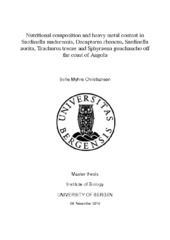Nutritional composition and heavy metal content in Sardinella maderensis, Decapterus rhoncus, Sardinella aurita, Trachurus trecae and Sphyraena guachancho off the coast of Angola
Master thesis
Permanent lenke
http://hdl.handle.net/1956/18939Utgivelsesdato
2018-11-20Metadata
Vis full innførselSamlinger
Sammendrag
In sub-Saharan Africa approximately 224 million people are undernourished (FAO, 2017a). Fish play an important role in enhancing the nutritional status and food security in Africa and is an important source of protein and micronutrients (FAO, 2017b). Completing nutrient profiles on different species is important to possibly aid in alleviating health concerns based on nutrient deficiencies. In addition, heavy metal content is important to investigate for all fish species which are to be consumed. Sampling of Sardinella maderensis, Decapterus rhoncus, Sardinella aurita, Trachurus trecae and Sphyraena guachancho was conducted off the coast of Angola in September-October 2017. The different analyses were completed at Institute of Marine Research laboratories. Phosphorus levels found in this thesis were around 250% higher than previously recorded results for Sardinella aurita; the phosphorus value was 344 mg/100 g (Table 4.2), while it was 98 mg/100 g from the previous study (Table 2.1). Calcium levels were higher for Sardinella maderensis and Sardinella aurita with values of 89.4 and 71.6 mg/100 g respectively, while the other three species studied ranged between 20.4 and 25.8 mg/100 g. More research is needed to accurately interpret the real contribution of these nutrients based on availability, access, and consumption, as well as more research on the potential health concern of heavy metal consumption of fish species in Angola.
